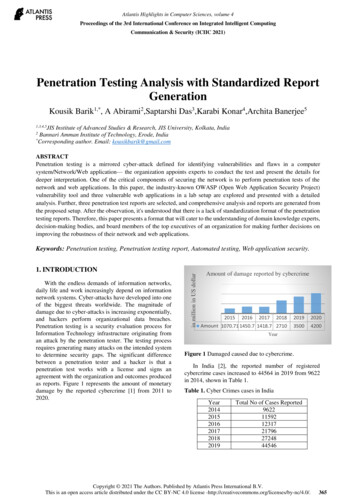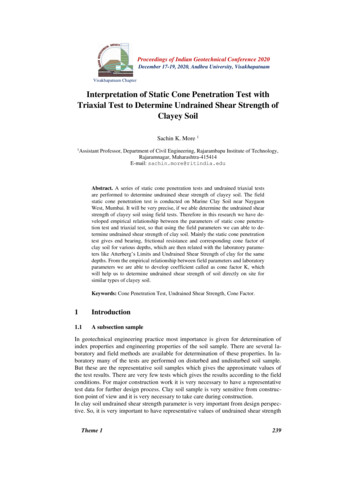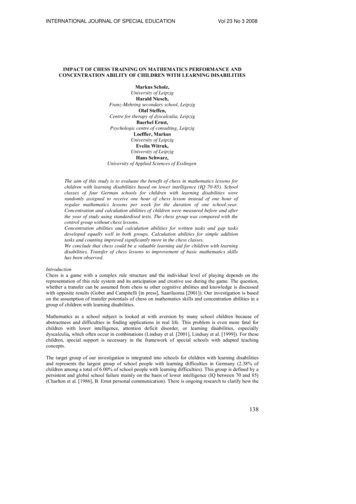
Transcription
Cosmet.Sci.,56, 283-295 (September/October2005)InvestiDationof penetrationabilities of variousoils intohuman hair fibersK. KEIS, D. PERSAUD, Y. K. KAMATH,and A. S. RELE,TRI Princeton,Princeton,NJ 08542 (K.K., D.P., Y.K.K.), andMarico IndustriesLtd., Andheri,Mumbai 400 058, India (A.S.R.).Acceptedfor publicationJune8, 2005.SynopsisIn this work we haveexploredcapillaryadhesionbetweenhair fiberstreatedwith differenttypesof oils.With coconut,olive,andsunfloweroilsthe capillaryadhesionwasfoundto decreasewith time, but not withmineraloil. Applicationof heatreducedthe capillaryadhesionfurtherfor coconutandsunfloweroils.Again,this wasnot observedwith mineraloil. Basedon an earlierstudy,wherecoconutoil wasfoundto penetratehair while mineral oil was unable to do so, it was hypothesizedthat the reductionin capillary adhesionresultedfromthepenetrationof oil into the fiber,leavinga thinneroil film onthe surface.Sucha reductionin capillaryadhesioncanbe explainedby changesin Laplacepressureand in the areasof liquid bridgesformed between the fibers.The thinningof oil films on the surfaceof hair hasbeenconfirmedindependentlyby goniophotometricmeasurementson singlehair fiberstreatedwith coconut,sunflower,and mineraloils. Thick films of oil(thickerthan -0.5 pro)areknownto maskthe scalestructure.As the oil is absorbedinto the hair, the filmthinswith time andapplicationof heat,andthe scalestructurereappears.This changecanbe convenientlydeterminedby measuringthe scaleangie, using the well tweenthe two methodssupportsthe conceptthat the reductionin capillaryadhesionbetweenhair fibersis mostlikely due to thinning of oil films by absorptionof oil into the hair.INTRODUCTIONVariousnatural oils are increasinglyusedin skin and hair careproducts,especiallyinethnichair products.In AsianandAfricancountries,vegetableoils arecommonlyusedashairpomadesandareknownto leadto healthy-lookinghair. Depositionof oilson hairhasbeenclaimedto havea beneficialprotectiveeffect.Oil-basedhair conditionersarethusbelievedto help preventmoisturelossfrom hair, whichcausesdrynessand lossofelasticity.Specifically,the beneficialeffectof coconutoil on the preventionof cuticulardamageduring combing,when usedas a prewashconditioner,hasbeendemonstratedpreviouslyby protein lossand water retention measurements(1). In addition to providinga lubricatingfilm, this effectwasexplainedby the hydrophobicityof coconutoil,which reducesthe water penetrationinto the fiber. For full beneficialeffect,oil penetrationthroughoutthe hair fiber cortexis desirable,asmechanicalpropertiesof the hairfiber are determinedby the cortex. However, the moisture-retentioneffect of oil is283
284JOURNAL OF COSMETIC SCIENCEdominatedby surface-depositedoil. Recently,RuetschetaL (2) showedthat coconutoilpenetratesinto the hair cortexand reducesthe swellingof the hair fiber.The presenceof oil films on the surfaceof fibersleadsto larreflectionof light fromthe surface.The magnitudeof thesetwo effectsdependson the thicknessof the oil film, determinedby the amountof oilapplied. Penetrationof oil into the fiber reducesthe film thickness,which affectsbothcapillaryadhesionand light reflection.In this paper,the penetrabilityof variousoils isstudiedby meansof the changesin interfiberadhesionand light reflectionmeasurements.The forceof adhesionbetweenfibersplaysan importantrole in describingfiberassemblybehaviorand is measuredusinga recentlydescribeddynamicfiber pull-outmethod(3). The capillaryadhesionforcemeasuredon a singlefiber due to its contactwith other fibers in the assemblyis sensitiveto the amount of oil on the fiber surface.Therefore,it is possibleto determinewhich oils are more readilydiffusedinto the hairfiber, therebyleavingthinnerfilms of oil on the surfacewithout "clumping"of the hairassembly.A goniophotometerrecordsthe angularprofile of reflectedlight and is frequentlyemployedto quantifyluster.This methodis alsoknown to serveasa sensitiveprobeofthe hair surface,mostly usedfor detectionof structuralchangescausedby cosmeticproductsandmechanicalgrooming(4-6). In thisstudywe demonstratethat thechangesin reflectedlight intensity,angularpositionfor specularreflectance,and calculatedscaleanglecanall be successfullyusedto detectthe changesin the thicknessof the surfaceoilfilm as a result of penetration.EXPERIMENTALMATERIALSThe hair usedin thisstudywasblackhairof Indianoriginsuppliedby MaricoIndustriesLtd., Mumbai, India. Purecoconutoil, mineraloil, and ricebranoilswerealsoprovidedby Marico IndustriesLtd. Cold-pressedextra-virginolive oil (Filippo Berio, Italy),expeller pressedsunfloweroil (Hain Pure Foods,Inc., New York), pure sesameoil(Kadoya, Summit Import Corp., New York), and pure mustard massageoil (KTCEdiblesLtd. England)were obtainedfrom commerciallyavailablesources(healthandfood stores).MEASUREMENTOF INTERFIBERADHESIONHair tresspreparation.Prior to treatment,the hair tresswaskept overnightat 21øC and65% RH. A hair tresswith a weight of 2 gramswasgently combedin orderto ensureparallel alignment of the hair fibers. Then 0.2 cc of the appropriateoil was directlyappliedto the tresswith a syringe.The oil wasgently massagedwith glovedfingersintothe tressfor five minutes to distribute it uniformly into the hair assembly.In theapplicationprocedurea small amountof oil is left on the glove,but is consideredto benegligible to havean effecton the measurement.Packingdensityandhairfibermounting.A detaileddescriptionof the methodis giveninreference3. toa specially
PENETRATIONOF OILS rwith a diameterof 0.8 cm by pulling the hair tressthrough the cylinder.The excessof hair fibers was removed.From the packedhairassemblya singlehair fiber waspartly pulled out in the root-to-tipdirectionfrom themiddle of the cylinder,and then attachedto a Kevlar monofilament.The Kevlar monofilamentwassubsequentlyattachedto a recordingelectrobalance(TRI-Scan)via a stainlesssteelhook.The forceof withdrawal(mg) wasrecordedwhile the TRI-Scan stagewasmovingdownwardat a rate of 0.02 mm/sec.From the curveof forceversusdistancemoved,an averageforcewas calculated.For eachoil treatment,measurementwas repeatedon ten specimens,i.e., pulling out ten singlefibers, one at a time, from eachpackedhair dafterkeepingthepackedcylinderat a constanttemperatureand humidity (21øC and 65% RH) for 24hours.A third setof ntusinga blow-dryerat medium heat for five minutes.Warm airflow was directedon bothcylinderwalls and its openings.Eventhoughthis procedureis not highly reproduciblein termsof the temperatureexperiencedby the hair assemblycomparedto a constanttemperatureoven,we usedthis proceduremainly becauseof its usein practice.MEASUREMENTOF ANGULARREFLECTEDLIGHTPROFILEThe goniophotometer(GP) wasusedto recordthe scatteredlight intensityasa functionof the angle. The light sourcewasa He-Ne laserof 632 nm. The measurementswereperformedon singleIndian hair fibersplacedhorizontallyin the sampleholder at anangleof incidenceof 45ø. The scaleangleo wascalculatedfrom the GP curvesof fiberin the root-to-tip (R-T) and tip-to-root(T-R) position,given by: o (f} :R- 0RT)/4,wheref}TRand f}RTstandfor the angleof specularpeakappearancefor tip-to-rootandroot-to-tip positions,respectively(4). Measurementswereperformedon the samefiberas in the caseof adhesionmeasurements,which were doneon the samehair assembly,directlyafter oil application,24 hoursafter oil application,and with short-termheattreatmentusinga blow-dryer.A thin oil layerwasappliedby movingthe fiber throughan oil drop at the tip of a needle.Additional scanswere recordedafter removingtheremainingsurfaceoil by dissolution,moving the fiber througha drop of acetone,asdescribedpreviously.RESULTSEFFECTANDOF VARIOUSDISCUSSIONOILS ONINTERFIBERADHESIONFiberwithdrawalforcesfor hair treatedwith variousoilsareshownin Table I. Comparedto untreatedIndian hair, the withdrawalforceis increasedby a factor 3 to 9 for all oilsusedin this study.The withdrawalforceof a fiber from a bundle is a functionof thenumberof pointsof contactandthe normalforcesacting(laterally)at thesepoints.Uponoil application,liquid bridgesare formed betweenfibers and additional normal forcearisesfrom the negativeLaplacepressuresof theseliquid bridges(capillaryadhesion).The magnitudeof the adhesiveforceis a productof the Laplacepressureof the liquidbridge and its area.Comparingthe initial withdrawal forces(i.e., directly after oil application)with forcesmeasuredafter 24 hours,we observea decreaseof about 20% for mustard and olive oil.
286JOURNAL OF COSMETIC SCIENCETableIAverageWithdrawalForceswith 95% ConfidenceLevelsfor VariousOil TreatmentsCalculatedfromthe DynamicInterfiber mg)force(mg)after 24 hrafter 24 hr w/heatUntreatedCoconut oil29.6 8.1116.2 7.7103.7 9.6Mineral oilSunflower oil107.4 2.8184.6 24.3110.5 1.7108.3 13.2Ricebran oil109.4 2.0109.8 1.8Mustard oil287.3 27.4221.2 19.3203 58.7192.2 85.5264.0 45.0192.0 61.0Sesame oilOlive oil63.9 10.4108.1 10.983.9 12.9For theseoils, resultsshowedconsiderablefiber-to-fiber variation, giving a large standarddeviation.The reasonfor this couldbe the changein the areaand thicknessof theoil films,leadingto unevenoil distributionon the fiber.Thereis no significantchangein withdrawal forcesfor mineral, sesame,and ricebranoil, whereasfor coconutoil andsunfloweroil, forcesafter 24 hourshave decreasedby 10% and 40%, respectively.Furtherdiscussionwill mainlyfocuson ndto give highly ncharacteristics.For theseoils, resultsaresummarizedandpresentedgraphicallyin Figure 1. Formineral oil, the withdrawal force remainsunchangedeven after heat treatment, suggestingthat the natureof the oil film and the associatedcapillaryadhesionremainunchanged.The differencein the initial adhesionforcebetweensunflower,coconut,andmineral oil-treated fibers could be due to the different cohesiveproperties.The withdrawal forces for coconut oil and sunflower oil after heat treatment are further decreasedby approximately40% and20%, respectively,comparedto theforcemeasuredafter24250[] Initial[] 24 hrs200[] 24hrs w/heat 50T10050CoconutMineralSunflowerFigure1. th coconut,mineral,andsunfloweroils,initially, after 24 hours,and with additionalheat treatment.
PENETRATIONOF OILS INTOHAIRFIBERS287hours.The major decreasein withdrawal forcefor sunfloweroil-treatedhair was foundto occur within 24 hours, whereas for coconut oil-treated hair the short-term heattreatment had the largesteffect.The lowest withdrawal force, i.e., the closestto theuntreated hair, was found for the coconut oil-treated hair after 24 hours with heattreatment.In Figures2-4 the typicalwithdrawalforcecurvesare shownfor mineral,coconut,and sunfloweroil-treated hair fibersafter 5 min, 24 h, and with heat treatment.The decreasein withdrawalforceis associatedwith changesin fiber-surfaceconditionandcanbe explainedasfollows.The forceof adhesionis determinedby the effectiveareaofthe liquid bridgesformed betweenfibers and by capillary pressure,which in turndependson the surfacetensionof the oil, the contactangle of the oil on the fiber, andthe curvatureof the liquid bridge.An equationfor the adhesiveforcedue to capillarityfor two parallelfibershasbeenderivedby Brookseta/. (7). A decreasein the amountofoil on the fiber surfaceby penetrationresultsin an increasein liquid bridgecurvatureand a decreasein contactarea,shownin Figure 5. From this combinedeffect,an initialincreasefollowed by a decreasein the withdrawal force is expected.Thus, decreasedwithdrawalforces found for sunflower and coconut oil-treatedhair fibers indicate thepenetrabilityof theseoils into the hair fibers,leadingto thinningof surfaceoil films.Unchangedwithdrawalforcesfor mineraloil imply the possiblelack of penetrationandfilm thinning. Thesefindingsare in good agreementwith fiber interior studiesperformedby secondaryion massspectrometry(SIMS)in combinationwith a time-of-flight(TOF) massspectrometer,where mineral oil was not detectedwithin the hair fiber crosssection,whereascoconutoil wasfound to penetratepartially or completely(2).EFFECTOF MINERALANDCOCONUTOILS ONGP MEASUREMENTSIt was the work of Stammet a/. (4) that showedthat the shift in the reflectance eaks160140'120A100602005 mmLength of Fiber MovedFigure 2. Typical withdrawal forcecurvesfor Indian hair fibers treatedwith coconutoil after 5 minutes(A), after24 hours(B), andafter24 hourswith heattreatment(C). Curvesshiftedarbitrarily.
288JOURNAL OF COSMETIC SCIENCE16014012010060402005 mmLength of Fiber MovedFigure 3. Typicalwithdrawalforcecurvesfor Indian hair fiberstreatedwith mineraloil after 5 minutes(A),after24 hours(B), and after24 hourswith heattreatment(C). Curvesshiftedarbitrarily.250200AE 5oE oo5OLength of Fiber Moved5mmFigure 4. Typicalwithdrawalforcecurvesfor Indianhair fiberstreatedwith sunfloweroil after5 minutes(A), after 24 hours(B), and after 24 hourswith heattreatment(C). Curvesshiftedarbitrarily.
PENETRATIONOF OILS INTOHAIRFIBERS289Figure 5. Schematicsof the oil liquid bridgebetweentwo fibers.Oil penetrationdecreasesthe contactarea,A rR2, andincreasestheLaplacepressure,P crcos0/r.wherecristhesurfacetensionofoil and0 isthecontactangle. The combinedeffectof thesetwo resultsin a decreasein adhesiveforce(P Al P2A2).for a hair fiber in the R-T and T-R modesat a given angleof incidencewasdue to thescaleangle. Depositionof thick oil films eliminated this shift by maskingthe scalestructurewith the oil film. For sucha system,the reflectancepeaksin the R-T and T-Rmodesoverlapped.In Figure6A the GP curvesrecordedin the R-T and T-R positionsfor an untreatedIndian singlehair fiber and for the samefiber treatedwith a mineraloilare shown.For the untreatedhair fiber the sharpspecularreflectancepeak occursat anangledifferentfromtheangleof incidence,dueto the inclinationof scalesrelativeto theaxisof the fiber. For R-T and T-R scans,the specularpeakshavea maximumat 38ø and52ø, respectively.From thesevaluesa scaleangle of 3.5ø for untreatedhair fiber iscalculated.After applicationof mineraloil, the specularreflectancepeaksoverlap,bothappearingat 45ø. The angleof reflectionbeingequalto the angleof incidenceindicatesthe formationof a smooth mirror-likeoil filmon the fiber surface. Hair-fiberscalestructureis no longerseen.Also, the sharperpeakswith higher reflectancecomparedtountreated hair fiber illustrate the lustrous surface withoutdiffuse reflectance. For mineraloil, the GP intensityscans,directlyafter oil treatment(not shownin Figure6A) andafter 24 hours,are similar regardingboth the peak positionas well as reflectedlightintensities.The additionalshoulderon the specularreflectancepeakfor R-T at a higherangleismostprobablycausedby thediscontinuityof film at certainlocations.After heattreatmentfor five minutes,the intensityof reflectancehasdecreasedby a factorof 1.6,as shownin Figure 6B. However,the shapeof the GP curveremainssimilar to thoseobtainedafter24 hours,with no separationindicativeof the scaleangle.Thus,evenafterthe heat treatment, most of the mineral oil remainson the hair surface.It is worthwhilementioning that the GP curvesremainedunchangedeven with heat treatment over alongerperiodof time (20 minutes).Finally, in orderto demonstratethe reproducibilityand reliability of the resultsand the method, the hair fiber was dipped into acetone,removingthe mineraloil film from the fiber surface.This resultedin the separationofscansfrom the R-T and T-R positions,giving a scaleangleof 3.4ø. Also, the reflectionintensitiesare comparableto onesobtained from the initial measurements.To some
290JOURNAL OF COSMETIC SCIENCEA0.05t Mineraloil24hiItiMineraloi124hII, R-T0.03I0.02j/'\untreatedT-RuntreatedR-T, 0.010.002O4O6080Scatteringangle(degrees)Bßral oil 24 h and heat0.025R-T0.020ß ' '0.015o.oo1 o,,eoveo,,eoveR-T l/vT-Ro.oo q[Io.ooo/I . .v'\' , ' \.020406080Scatteringangle (degrees)Figure 6. Goniophotometricintensityscans:(A) IndividualuntreatedIndianhair fiberand24 hoursaftermineraloil application.(B) 24 hoursaftermineraloil applicationwith short-termheattreatmentandafterremoval of oil film with acetone.
PENETRATIONOF OILS emay be explainedby mineraloil residues,especiallyaroundthe scaleedges.Thus, usinga goniophotometeras an optical tool to studythesurfacecondition of the hair fiber, we conclude that mineral oil forms a smooth andstablefilm on the top of the cuticularsheath.Mineral oil doesnot penetrateextensivelyinto the hairfiber in a 24-hourperiod,not evenat elevatedtemperatures.Reductioninpeak intensityafter heat treatmentis likely to be due to the penetrationof a smallamount of oil into the cuticularsheath,leavingmost of it on the surface.In Figure 7A the GP intensityscansare shownfor untreatedIndian hair fiber recordedin the R-T and T-R positions.Figure 7 alsodisplaysthe reflectancecurveswhen thesamefiberwastreatedwith coconutoil. As describedabove,a scaleangleof 3.6øis foundfrom the displacementof specularpeaksfrom the angle of incidence.Coconutoiltreatmentcoversthe scalestructureand resultsin sharpspecularreflectancewith increasedpeakintensities.After 24 hoursthe reflectionintensityhasdecreasedby a factorof 1.9 (seeFigure7B). However,peaksarestill positionedaroundthe angleof incidence.Applicationof heattreatmentfor onlya few minutesinducesa tremendouschangein theGP curves,with partial separation,as seenin Figure 7C. Intensity scansfrom the T-RandR-T positionsshowa reductionin total areobserved,indicatingthe changein the surfacedistributionof oil residues,the fiber scalestructureis likely to be exposed.Thus, the majoramountof depositedoilfilm on the surfacehasindeedpenetratedinto the hair fiber. Dipping the fiber intoacetoneremovesthe remainingoil and resultsin scansmatchingthoseof the untreatedfiber, as shownin Figure7D. The scaleangleis again3.5ø.Results from coconut oil treatmentdiffer fromthose from mineraloil treatmentinseveralways. Although measuredintensity does not allow exact quantification,thechangesin relative intensitiescan be usedas estimatesas long as measurementsareperformedon the samefiber underidenticalconditions.Hence,the reductionin intensityafter24 hourscouldindicatethe decreasein coconutoil film thicknesscoveringthehairfiber.For mineraloil, the reflectedlight at coconutoil may haveat leastpartiallypenetratedthe hair fiber within24 hours.After 24 hoursthe remainingsmoothcoconutoil film must be very thin,consideringthe effectof short-timeblow-drying.Severalstudiesconductedat TRI havedemonstratedthe looseningof scaleedgesand the formationof half-domesupon heattreatment of hair fibers. Under suchconditions,oil can wick into the cuticular structure.If so, then both mineral and coconutoil shouldpenetrateinto the hair becausetheirsurfacetensionsare similar.Although oils can wick by capillaritybetweenseparatedcuticlecellsat the surfacewherethe cellsmay be separated,their penetrationinto theentirecuticlesheathand the cortexdoesnot occurby capillarity.The fact that coconutoil wasfoundto penetrateandmineraloil doesnot supportsthis hypothesis.Becauseofthe much smaller volume, the cuticle can accommodateonly a small amount of oil.Therefore,theseGP observationsshowthat oilspenetrateinto the bulk of hair and skinby moleculardiffusion.EFFECTOF OTHEROILS ONGP MEASUREMENTSWe alsoconductedmeasurementswith variousotherplant-derivedoils. For hair treatedwith mustard oil, the scalestructure remained coveredafter 24 hours, even after addi-
292JOURNAL OF COSMETIC SCIENCEA0.12 coconutoil 2 min.Ii0.10 T-RIiIiIiß 0.08ß --I0.06lcoconutoil2min.0.04untreatedR-T/k,,,111 ;. n eatedT-R0.02---iß lBI0.0020406O80Scatteringangle (degrees)B0.07coconut oil 24 hrs.5o.o5 T-Roi 0.04. ß o.o3 coconutoil24 hrs.'l lR-TT-RuntreatedR-' '\ 11 1 untreated0.010.00. . .,, -.,--,a ,- a ---- ,, '- --,02o40 , --' - .60 -,,,,80Scatteringangle (degrees)Figure 7. Goniophotometricintensityscans:(A) tercoconutoil application.(B)24 hoursaftercoconutoil applicationcomparedto untreatedfiber.(C)24 hoursaftercoconutoil applicationwith short-termheat treatment.(D) After removalof oil film with acetone.tional heat treatment. Also, for hair treated with sesame,ricebran,and olive oils, thescalestructurewasnot apparentfromthe GP curvesevenafter24 hours,suggestingnopenetration.For olive oil, however,partial separationof reflectancepatternsfrom the
PENETRATIONOF OILS INTOHAIRFIBERS293c0.0250.020coconutoil 24 hrs. w. heat0.0150.010O.0O50.0000iiii20406080Scattering angle (degrees)D0.05oilremovedI/0.03o ,l removed0.020.010.00020406080Scattering angle (degrees)Figure 7. Continued.T-R and R-T positionsappearedafter additionalheat treatment.Surprisingly,for hairtreatedwith sunfloweroil, the scaleedgeswerepartly exposedafter24 hours,indicatingat leastpartial penetrationof sunfloweroil into the fiber. As GP scanscharacterizeonly
294JOURNAL OF COSMETIC SCIENCEthe hair surfacecondition,it is not possibleto determineif sunfloweroil penetrationhasoccurredonly within the cuticularlayer or throughoutthe hair fiber, involving thecortex.In general,polyunsaturatedoils do not seemto diffuseinto hair. SaturatedandmonounsaturatedDIFFUSIONoils seem to diffuse into the hair structure.MECHANISMIt is known that diffusionof small moleculessuchasdyesand surfactantsin wool l membranecomplexes,CMCs (8). Itis alsoknown that surfactantssuchas sodiumlauryl sulfatediffuseinto protein structureseffectivelybecauseof their ability to solubilizeproteinsby complexation(9). Sincewe are consideringthe diffusionof oils that are unchargedtriglycerides,this may beirrelevantin this instance.Basedon the work referencedabove,the diffusionor penetrationability of small moleculeswould be expectedto be throughthe CMCs, controlled by the affinity of the moleculesfor nonkeratinousproteinsin the CMCs, molecularstructure,and molecularweight. For example,mineraloil doesnot diffuseintohair becauseit is nonpolar,containinglonglinearhydrocarbonchainswith lengthsaboveC-20. Eventhoughthe straight-chainmolecularstructureis favorablefor diffusionbyreptation,lackof affinityseemsto preventit fromdiffusinginto hair.Vegetableoils,onthe otherhand,consistof triglyceridemoleculesin which threefatty acidmoleculesarenaturallyesterifiedto the three hydroxylgroupsof a glycerolbackbone.For example,coconutoil is rich in lauricacid(C-12 triglyceride),whereasin sunfloweroil linoleicacid(C-18:2 triglyceride)is predominant.Becauseof its polarcharacter,coconutoil seemstohavean affinity towardproteinmoleculesin the CMCs, and, therefore,this oil penetratesmorereadilyinto hair fiberscomparedto mineraloil. SinceC-12 fatty acidis a straightchainfatty acid,the molecularstructureof the triglycerideis alsofavorablefor diffusion.Diffusionoccursby an acid-basetype of interactioninvolvingthe estergroupsin the oiland the carboxyland amine groupsin the protein. Oils containingtriglycerideswithunsaturatedfatty acidsseemto encountergreaterresistanceto diffusion.Thesemoleculestend to be more spreadout becauseof the presenceof multiple doublebondsand arethereforedifficult to enter and movethroughthe narrowchannelsof the CMCs. Theseaspectsneed to be exploredfurther, basedon the dynamicsof thesemoleculesin aprotein environment.CONCLUSIONSThe work reportedin this paper showsthat the formationof oil films in hair fiberassembliescan be studied by two very different methods,interfiber adhesionand reflectanceof light. There seemsto be goodcorrespondencebetweenthe two methods,asshownby the agreementbetweenthe two methodsfor coconut,mineral,sunflower,andoliveoils.In to the hair becauseof a compactmolecularstructureandthe polarheadgroupof the triglyceridemoleculesthat constitutetheseoils. In a dynamicmode thesemoleculescan reptateand squeezethroughthe CMCs. On the other hand,polyunsaturatedoils do not penetrateinto hair,most likely becauseof the more open and spread-outstructuresof their triglyceridemoleculesandbecauseof the presenceof multiple doublebonds.The resultsreportedin
PENETRATIONOF OILS INTOHAIRFIBERS295thiswork showa complexrelationshipbetweencapillaryliquid films, interfibercapillaryadhesion,light reflectance,fiber surfaceand bulk structure,and moleculardiffusion.ACKNOWLEDGMENTSThese studieswere carried out in conjunctionwith the TRI project "AnalysisandQuantificationof Hair Damage,"supportedby a group of TRI corporateparticipants.This study was also partially funded by Marico IndustriesLtd. We thank Mr. R. B.Mohile for his support.REFERENCES(1) A. S. Rele andR. B. Mobile, Effectof coconutoil on preventionof hair damagePart I,J. Cosmet.Sci.,50, 327 (1999).(2) S. B. Ruetsch,Y. K. Kamath, A. S. Rele, and R. B. Mohile, Secondaryion massspectrometricinvestigationof penetrationof coconutand mineraloils into humanhair fibers:Relevanceto hair damage,J. Cosmet.Sci.,52, 169 (2001).(3) Y. K. Kamath and H.-D. Weigmann, Measurementof interfiber adhesion,J. Cosmet.Sci., 51, 351(2000).(4) R. F. Stamm,M. g. Garcia,andJ. j. Fuchs,The opticalpropertiesof humanhair. II. Lusterof hairfibers,J. Soc.Cosmet.Chem.,28, 601 (1977).(5) A. Guiolet,J. C. Garson,andJ. L. Levecque,Studyof the propertiesof humanhair, I,t.J. Cosmet.ScL,9, 111 (1987).(6) C. ReichandC. R. Robbins,Light scatteringandshinemeasurementof humanhair:A sensitiveprobeof the hair surface,J.Soc.Cosmet.Chem.,44, 221 (1993).(7) J. H. Brooks,U.K. Das, and L.J. Smith, Effect of lubricationon tensile frictional and weavingpropertiesof sirospunwool yarn, TextileRes.J., 59, 382 (1989).(8) P. N. Moore, S. Puvvada,and D. Blanckschtein,Role of surfactantpolar headstructurein proteinsurfactantconcentration,Langmzdr,19, 1009 (2003).(9) V. Sideris,L.A. Holt, and I.H. Leavet, A microscopicalstudy of the pathway for diffusionofrhodamineB and octadecylrhodamineB into wool fibers,J. Soc.DyersColorists',106, 1 (1990).
The hair used in this study was black hair of Indian origin supplied by Marico Industries Ltd., Mumbai, India. Pure coconut oil, mineral oil, and ricebran oils were also provided by Marico Industries Ltd. Cold-pressed extra-virgin olive oil (Filippo Berio, Italy), expeller pressed sunflower oil (Hain Pure Foods, Inc., New York), pure sesame oil











